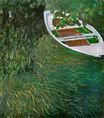Claude Monet - The Pink Skiff, Boating on the Ept 1887
 |
 |
 |
 |
 |
 |
 |

The Pink Skiff, Boating on the Ept 1887
135x175cm oil/canvas
Museu de Arte de São Paulo Assis Chateaubriand
The image is only being used for informational and educational purposes
<< Previous G a l l e r y Next >>
From The National Gallery of Australia, Canberra:
Kunisada’s Abalone fishing has the characteristic liveliness of a nineteenth-century Japanese artist’s depiction of plebeian contemporary life, quite different from the dreamy mood of the two bourgeois girls in Monet’s The pink skiff. There are similarities, however, between the way each artist has cut their brightly coloured boat by the frame and angled it into the scene. In both works the empty plane of water in the foreground is animated by curving lines. In a letter of June 1890 Monet wrote: ‘I have again taken up things impossible to do: water with grass waving in its depths…’ His obsession with representing the almost invisible movements below the surface of the water caused him to abandon his plan to paint a figure in a boat. If the Kunisada print hung, as it does today, in the ‘small salon’ at Giverny, one can imagine Monet studying the Japanese artist’s depiction of water rippling over seaweed, and pondering how to paint ‘the intangible, the ungraspable’, before going out to the little river and trying the ‘impossible’. This may be one reason why he never painted figures after 1890. He was seeking to express the relationship between his consciousness and a nature that he perceived as a structure of interacting, constantly changing forces. In such a relationship, the human figure was simply a distraction.